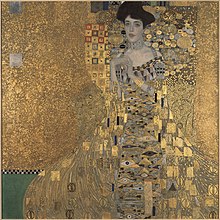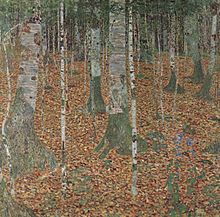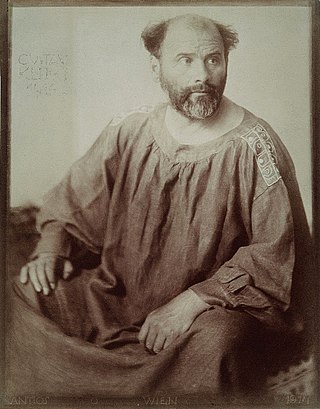
Gustav Klimt was an Austrian symbolist painter and one of the most prominent members of the Vienna Secession movement. Klimt is noted for his paintings, murals, sketches, and other objets d'art. Klimt's primary subject was the female body, and his works are marked by a frank eroticism. Amongst his figurative works, which include allegories and portraits, he painted landscapes. Among the artists of the Vienna Secession, Klimt was the most influenced by Japanese art and its methods.

The Belvedere is a historic building complex in Vienna, Austria, consisting of two Baroque palaces, the Orangery, and the Palace Stables. The buildings are set in a Baroque park landscape in the third district of the city, on the south-eastern edge of its centre. It houses the Belvedere museum. The grounds are set on a gentle gradient and include decorative tiered fountains and cascades, Baroque sculptures, and majestic wrought iron gates. The Baroque palace complex was built as a summer residence for Prince Eugene of Savoy.

The Foreign Sovereign Immunities Act of 1976 (FSIA) is a United States law, codified at Title 28, §§ 1330, 1332, 1391(f), 1441(d), and 1602–1611 of the United States Code, that established criteria as to whether a foreign sovereign nation is immune from the jurisdiction of U.S. courts—federal or state. The Act also establishes specific procedures for service of process, attachment of property and execution of judgment in proceedings against a foreign state. The FSIA provides the exclusive basis and means to bring a civil suit against a foreign sovereign in the United States. It was signed into law by United States President Gerald Ford on October 21, 1976.

The Neue Galerie New York is a museum of early twentieth-century German and Austrian art and design located in the William Starr Miller House at 86th Street and Fifth Avenue in New York City. Established in 2001, it is one of the most recent additions to New York City's famed Museum Mile, which runs from 83rd to 105th streets on Fifth Avenue in the Upper East Side of Manhattan.

The Österreichische Galerie Belvedere is a museum housed in the Belvedere palace, in Vienna, Austria.
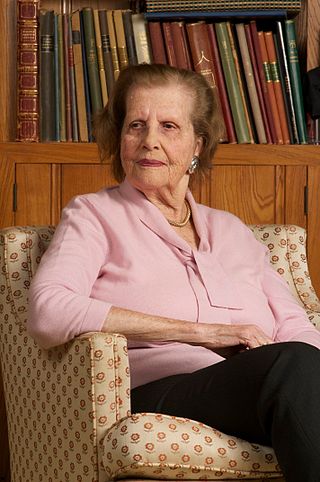
Maria Altmann was an Austrian-American Jewish refugee from Austria, who fled her home country after it was annexed to the Third Reich. She is noted for her ultimately successful legal campaign to reclaim from the Government of Austria five family-owned paintings by the artist Gustav Klimt that were stolen by the Nazis during World War II.

The Kiss is an oil-on-canvas painting with added gold leaf, silver and platinum by the Austrian Symbolist painter Gustav Klimt. It was painted at some point in 1907 and 1908, during the height of what scholars call his "Golden Period". It was exhibited in 1908 under the title Liebespaar as stated in the catalogue of the exhibition. The painting depicts a couple embracing each other, their bodies entwined in elaborate beautiful robes decorated in a style influenced by the contemporary Art Nouveau style and the organic forms of the earlier Arts and Crafts movement.
Hubertus Czernin was an Austrian investigative journalist.

Portrait of Adele Bloch-Bauer I is a painting by Gustav Klimt, completed between 1903 and 1907. The portrait was commissioned by the sitter's husband, Ferdinand Bloch-Bauer, a Jewish banker and sugar producer. The painting was stolen by the Nazis in 1941 and displayed at the Österreichische Galerie Belvedere. The portrait is the final and most fully representative work of Klimt's golden phase. It was the first of two depictions of Adele by Klimt—the second was completed in 1912; these were two of several works by the artist that the family owned.
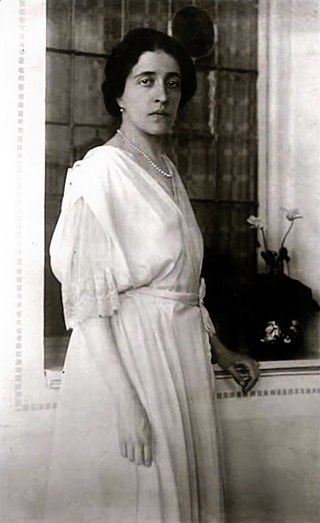
Adele Bloch-Bauer was a Viennese socialite, salon hostess, and patron of the arts from Austria-Hungary. A Jewish woman, she is most well known for being the subject of two of artist Gustav Klimt's paintings: Portrait of Adele Bloch-Bauer I and Portrait of Adele Bloch-Bauer II, and the fate of the paintings during and after the Nazi Holocaust. She has been called "the Austrian Mona Lisa."

Eric Randol Schoenberg is an American lawyer and genealogist, based in Los Angeles, California, specializing in legal cases related to the recovery of looted or stolen artworks, particularly those by the Nazi regime during the Holocaust.

Portrait of Adele Bloch-Bauer II is a 1912 painting by Gustav Klimt. The work is a portrait of Adele Bloch-Bauer (1881–1925), a Vienna socialite who was a patron and close friend of Klimt.
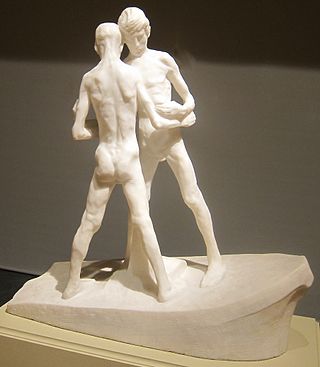
George (Georges) Minne was a Belgian artist and sculptor famous for his idealized depictions of man's inner spiritual conflicts, including the "Kneeling Youth" sculpture series. A contemporary of Gustav Klimt and Egon Schiele, Minne's work shows many similarities in both form and subject matter to the Viennese Secessionists, the fathers of Art Nouveau.

Judith and the Head of Holofernes is an oil painting by Gustav Klimt, painted in 1901. It depicts the biblical figure Judith holding the head of Holofernes after beheading him. The beheading and its aftermath have been commonly portrayed in art since the Renaissance, and Klimt himself would paint a second work depicting the subject in 1909.

Woman in Gold is a 2015 biographical drama film directed by Simon Curtis and written by Alexi Kaye Campbell. The film stars Helen Mirren, Ryan Reynolds, Daniel Brühl, Katie Holmes, Tatiana Maslany, Max Irons, Charles Dance, Elizabeth McGovern, and Jonathan Pryce.

Bernhard Altmann (1888–1960) was an Austrian textile manufacturer whose business was stolen and whose family's art collection was looted by Nazis because of their Jewish origins. He introduced cashmere wool to North America on a mass scale in 1947.
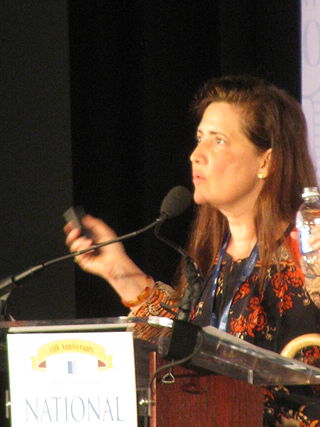
Anne-Marie O'Connor is an American journalist and writer who authored The Lady in Gold: The Extraordinary Tale of Gustav Klimt's Masterpiece, Portrait of Adele Bloch-Bauer, the bestselling story of the battle by Vienna emigre Maria Altmann to reclaim five Gustav Klimt paintings from her native Austria in an eight-year legal battle by Los Angeles attorney E. Randol Schoenberg; a saga that also inspired a Harvey Weinstein movie, Woman in Gold, in which Helen Mirren played Maria Altmann. One of the paintings, Portrait of Adele Bloch-Bauer I sold for a record $135 million in 2006, to Ronald Lauder's Neue Galerie New York, where the painting is on view.
Stealing Klimt is a 2007 documentary film about Maria Altmann's attempt to recover five Gustav Klimt paintings stolen from her family by the Nazis in 1938, from Austria.

The Accidental Caregiver: How I Met, Loved, and Lost Legendary Holocaust Refugee Maria Altmann is a 2012 memoir by Gregor Collins, recounting the three years he was a caregiver for Maria Altmann, as well as a stageplay, which premiered at the Robert Moss Theater in New York City on January 26, 2015.


